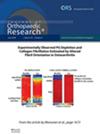Early Biomechanical Recovery Following Total Hip Arthroplasty Is Associated With Preoperative Hip Muscle Fat-Fraction
Abstract
Understanding risk factors for delayed functional recovery following total hip arthroplasty (THA) is a critical gap in postoperative rehabilitation. The purpose of this study was to assess for imaging factors associated with change in biomechanical function following THA. We hypothesized that muscle quality (as quantified by fat-fraction) and arthritis (OA) severity, as determined from advanced magnetic resonance imaging (MRI) sequences, would be associated with biomechanical recovery. Ten patients undergoing primary THA for OA were prospectively recruited and underwent preoperative MRI with advanced sequences to assess hip muscle fat-fraction and OA severity. Biomechanical function was assessed using 3D motion analysis of sit-to-stand movement tasks. Relationships between muscle fat-fraction, OA severity, and biomechanical function were assessed using a Spearman's rank correlation coefficient (ρ). Preoperative biomechanical function was most strongly associated with OA severity (ρ = −0.68, p = 0.03), with more severe OA predicting worse biomechanical function. Muscle fat-fraction was not related to preoperative function. Postoperative biomechanical function was most strongly associated with preoperative muscle fat fraction (gluteus medius: ρ = −0.58, p = 0.08; gluteus minimus: ρ = −0.72, p = 0.02; tensor fascia lata: ρ = −0.59, p = 0.07), with worse muscle fat-fraction predicting poor function. OA severity was not associated with postoperative function (ρ = 0.22, p = 0.54). Importantly, muscle fat-fraction was not related to OA severity. Radiographic OA severity was the best predictor of preoperative biomechanical function, but postoperative function was best predicted by preoperative muscle fat-fraction.
Clinical Significance
While the impact of OA on biomechanical function may be corrected with arthroplasty, muscle quality is not addressed with THA and may represent a target for patient-specific optimization and rehabilitation.

 求助内容:
求助内容: 应助结果提醒方式:
应助结果提醒方式:


